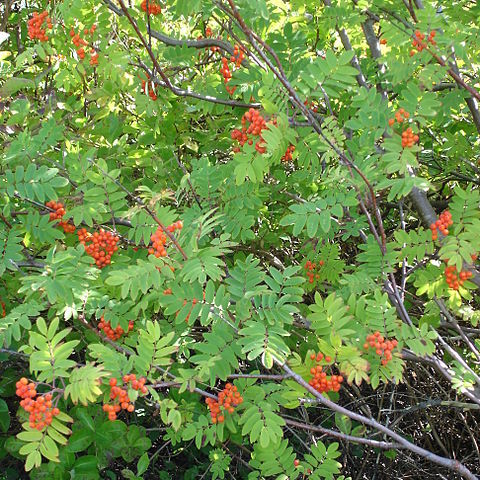Shrubs or trees, 10–300 dm. Stems 1–8, erect or ascending; bark gray to brown or bronze, ?usually smooth, becoming scaly with age, with conspicuous horizontal lenticels?; long and short shoots present; unarmed; ?twigs with smell and taste of bitter almond (cyanogenic glycosides)?; glabrous or hairy. Leaves deciduous, cauline, simple or odd (rarely even) pinnately lobed or divided; stipules usually early deciduous, sometimes persistent, free or short-adnate to petiole, linear, ovate to lanceolate, or flabellate, margins entire or dentate to laciniate; petiole present; blade ovate to oblong, 5–33 cm, membranous to slightly leathery, leaflets 0 or 7–17(–19), ?usually opposite, rarely alternate?, elliptic, ovate, oblong to lanceolate or oblanceolate, margins flat, sharply serrate to nearly entire, venation pinnate, surfaces glabrous or hairy, sometimes glaucous. Inflorescences terminal, 6–400+-flowered, panicles, ?flat-topped or rounded?, glabrous, glaucous, or hairy; bracts present; bracteoles absent. Pedicels present. Flowers opening after leaf expansion, perianth and androecium epigynous or 1/2 epigynous, ?odor strong, often considered unpleasant or rancid?, 5–17 mm diam.; hypanthium ?green to red?, obconic, 2–6 mm, glabrous or hairy; sepals 5, erect or ascending, ovate or triangular; petals 5, white or pink [red], suborbiculate or broadly obovate to broadly ovate, ?base clawed or not, claw often ± villous?; stamens [10–]14–20[–44] in 2 or 3 series, usually slightly longer than petals; carpels 2–5, distinct, partially or wholly connate and adnate to all or proximal 1/2 of hypanthium, usually apically woolly, styles ?2–5?, terminal, distinct or connate 1/2 of length; ovules 2 or 3[or 4] (all but 1 usually aborting). Fruits pomes, usually orange or red, rarely brown or yellow [green, white, or pink], globose to ovoid, obovoid, ellipsoid, or oblong, [pyriform], 4–19 mm, ?smooth or with lenticels, shiny, sometimes glaucous?, hairy or glabrous; ?flesh usually with sclereids?; hypanthium persistent; sepals usually persistent, rarely deciduous, usually incurved, ?fleshy?; carpels cartilaginous; styles often persistent. Seeds 3–5, ?brown to reddish brown or yellowish, darkening with maturity, ovoid to lanceoloid, slightly asymmetric and flattened?. x = 17.
Unarmed, deciduous trees or shrubs; trunk usually well-developed with branches forming a spreading crown; young stems often hairy; bark of older stems usually greyish. Lvs imparipinnate, with serrate or entire leaflets, or simple and toothed or lobed; stipules often deciduous, sometimes persistent and conspicuous on flowering shoots. Fls in large, showy, compound corymbs, or rarely panicles, terminating short shoots, usually with 2 uppermost lvs subtending outer part of infl., 5-merous, ☿, shortly pedicellate, mostly small. Hypanthium obconic to urceolate. Epicalyx 0. Sepals short and lanceolate or triangular, connate at base, usually persistent, sometimes deciduous. Petals 5, spreading, white or rarely pink or pale yellow. Stamens 15-20. Ovary semi-inferior or inferior; carpels 2-5, partly free or fused, ± enclosed by receptacle; styles as many as carpels, free or partly fused; ovules 2 in each locule. Fr. a small or rarely large, dryish or mealy pome, usually red to orange, sometimes yellow, brownish, white or pink; carpels thin-walled and becoming cartilaginous or membranous; seeds 1-2 in each locule.
Hypanthium obconic; sep triangular, ascending; pet 5, obovate to orbicular, spreading; stamens 15–20; pistils in our spp. 2–4, half-inferior, ± separate above, the styles distinct; fr a small orange-red pome, each locule with 1 or 2 elongate, flattened seeds; trees or shrubs with odd-pinnate lvs (lfls in ours 11–17) and numerous white fls in branched, round or flattened clusters. Often submerged in Pyrus. 100, N. Temp.

